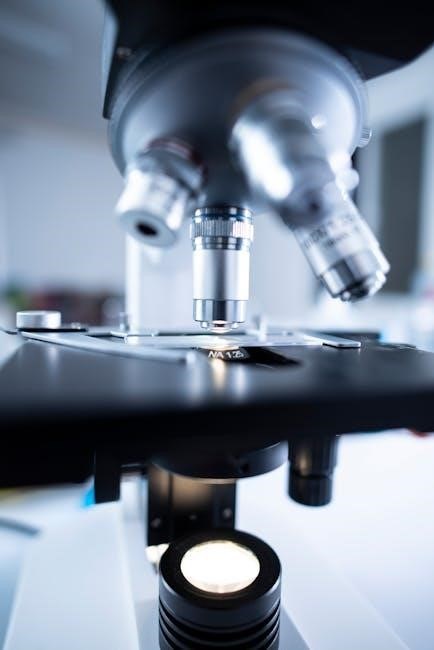PDF microbiology refers to digital documents covering microbiological topics, offering comprehensive insights into microorganisms, their roles, and applications in various fields like medicine, environment, and industry․
1․1 What is Microbiology?
Microbiology is the scientific study of microorganisms, including bacteria, viruses, fungi, and protozoa․ It explores their structure, function, and interactions with the environment and hosts․ Microbiologists investigate how these organisms impact health, ecosystems, and industries․ The field encompasses both basic research, such as understanding microbial evolution, and applied research, like developing antibiotics or vaccines․ Microbiology is essential for addressing global challenges, including infectious diseases, environmental conservation, and food production․ Advances in microbiology have led to breakthroughs in medicine, biotechnology, and our understanding of the microbial world․ This discipline continues to evolve with emerging technologies, making it a cornerstone of modern science and its applications․
1․2 Importance of Microbiology in Today’s World
Microbiology plays a vital role in addressing contemporary global challenges․ It is instrumental in combating infectious diseases through the development of vaccines and antibiotics․ In environmental science, microbiology aids in pollution control and waste management by utilizing microorganisms for bioremediation․ The food industry relies on microbiology for food safety, fermentation, and production processes․ Additionally, microbiology contributes to industrial applications, such as biofuel production and biotechnology advancements․ Understanding microorganisms also helps in agriculture, enhancing soil fertility and crop yields․ The importance of microbiology extends to public health, where it informs disease prevention strategies and diagnostic techniques․ As a result, microbiology remains a cornerstone of scientific progress and innovation, impacting nearly every aspect of modern life․
1․3 History of Microbiology
The history of microbiology dates back to the 17th century when Antonie van Leeuwenhoek first observed microorganisms using a microscope․ His discoveries laid the foundation for understanding the microbial world․ In the 19th century, Louis Pasteur’s germ theory revolutionized medicine, linking microorganisms to diseases․ Robert Koch further advanced the field by establishing criteria to connect specific microbes to diseases․ The Golden Age of Microbiology in the late 19th and early 20th centuries saw significant advancements, including the discovery of vaccines and antibiotics․ Modern microbiology has expanded into molecular biology, genetics, and biotechnology․ This rich history underscores the evolution of microbiology as a scientific discipline, shaping our understanding of life and health․
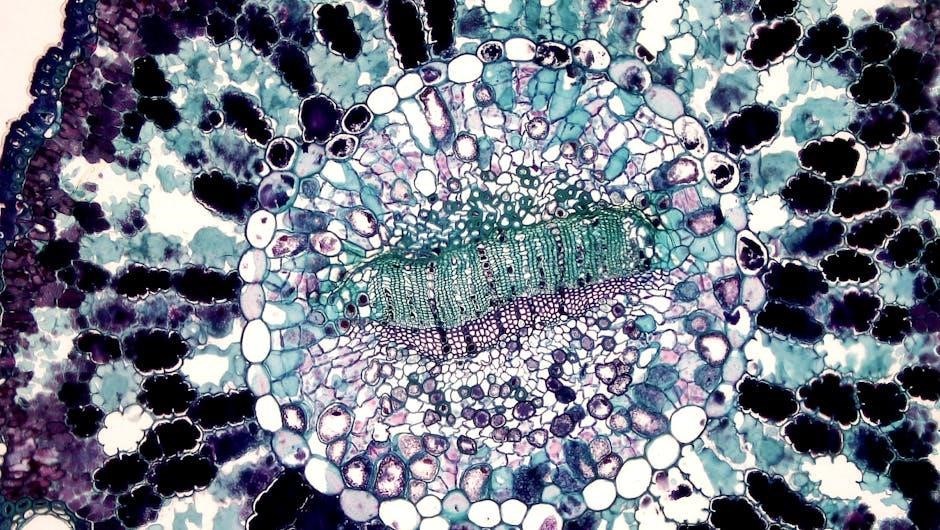
Key Concepts in Microbiology
Microbiology explores microorganisms, including bacteria, viruses, fungi, and protozoa․ It delves into their structures, functions, classifications, and roles in health, disease, and ecosystems, forming its core concepts․
2․1 Microorganisms: Types and Characteristics
Microorganisms are diverse, ranging from bacteria, viruses, fungi, and protozoa․ Bacteria are prokaryotic cells with cell walls, while viruses are parasitic particles requiring hosts․ Fungi, like yeast and molds, obtain nutrients by decomposing organic matter․ Protozoa are single-celled eukaryotes, often motile and heterotrophic․ Each type has unique characteristics, such as cell structure, metabolism, and reproduction methods, which influence their roles in ecosystems, human health, and industries․ Understanding these differences is crucial for applications in medicine, environmental science, and biotechnology, as their characteristics determine their interactions with environments and hosts․
2․2 Bacteria: Structure, Function, and Classification
Bacteria are prokaryotic microorganisms with a simple cell structure consisting of a cell wall, cytoplasmic membrane, and cytoplasm․ They lack a nucleus and organelles, but contain ribosomes for protein synthesis․ Many bacteria have appendages like pili for attachment and flagella for motility․ Capsules or slime layers provide protection․ Bacteria are incredibly diverse, with roles in decomposition, nitrogen fixation, and symbiosis․ They are classified based on shape (bacilli, cocci, spirilla), metabolism (aerobic/anaerobic), and genetics (Gram-positive vs․ Gram-negative)․ This classification aids in understanding their ecological roles, pathogenic potential, and industrial applications, making them central to microbiology, medicine, and biotechnology․
2․3 Viruses: Structure, Replication, and Impact
Viruses are obligate parasites with a structure consisting of genetic material (DNA or RNA) enclosed in a protein coat (capsid)․ Some have an outer lipid envelope․ They infect all forms of life, hijacking host cells to replicate․ Replication involves attaching to and penetrating the host cell, unleashing genetic material to direct viral assembly․ Viruses cause diseases like COVID-19, HIV, and influenza, impacting human health globally․ They also play ecological roles, influencing microbial populations and evolution․ Their unique lifecycle and adaptability make them significant in microbiology, medicine, and biotechnology, while their impact on ecosystems and economies underscores their importance in scientific study and public health strategies․
2․4 Fungi: Role and Significance in Microbiology
Fungi are eukaryotic organisms that play a vital role in decomposition, nutrient cycling, and symbiotic relationships․ They are heterotrophic, obtaining nutrients by decomposing organic matter or forming partnerships with other organisms, such as mycorrhizae with plants․ Fungi are indispensable in industries like food production, pharmaceuticals, and biotechnology, contributing to the creation of products like bread, cheese, and antibiotics, notably penicillin․ Their ability to produce enzymes makes them essential in various industrial processes․ Additionally, fungi are key players in environmental microbiology, aiding in bioremediation by breaking down pollutants․ Their diverse roles highlight their significance in both ecological balance and human innovation, making them a cornerstone of microbiological study and application․
2․5 Protozoa: Biology and Medical Relevance
Protozoa are single-celled eukaryotic microorganisms that exhibit both animal-like and plant-like behaviors․ They are classified based on their mode of locomotion and nutrition, with species ranging from free-living forms in water and soil to parasitic organisms that infect hosts․ Many protozoa, such as Paramecium, are harmless and play vital roles in ecosystems by regulating bacterial populations and decomposing organic matter․ However, some species, like Plasmodium (causing malaria) and Entamoeba histolytica (causing amoebiasis), are significant human pathogens․ Their complex life cycles and ability to evade host immune systems make them challenging targets for treatment․ Understanding protozoa is essential for developing therapeutic strategies against infectious diseases and appreciating their ecological importance․
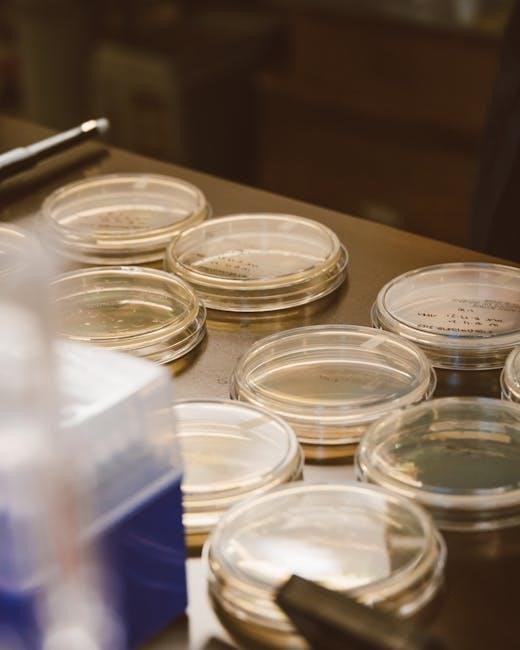
Microbiological Techniques
Microbiological techniques are methods used to study microorganisms, including culturing, microscopy, and molecular analysis, essential in medicine, environmental science, and food safety to understand microbial behavior, diagnose diseases, and develop treatments․
3․1 Microbial Culturing: Methods and Applications
Microbial culturing is a fundamental technique in microbiology, involving the growth of microorganisms in controlled laboratory conditions․ It allows researchers to isolate, identify, and study microbial species․ There are various methods, including solid agar plates, liquid cultures, and selective media, each tailored for specific microbial types․ Solid media, such as nutrient agar, enable the formation of discrete colonies, while liquid media support large-scale growth for industrial applications․ Selective media inhibit unwanted organisms, ensuring the cultivation of target species․ Applications range from medical diagnostics to biotechnology, where microbes are used to produce antibiotics, enzymes, and other valuable compounds․ Understanding microbial culturing is essential for advancing research and solving real-world problems in medicine, agriculture, and environmental science․
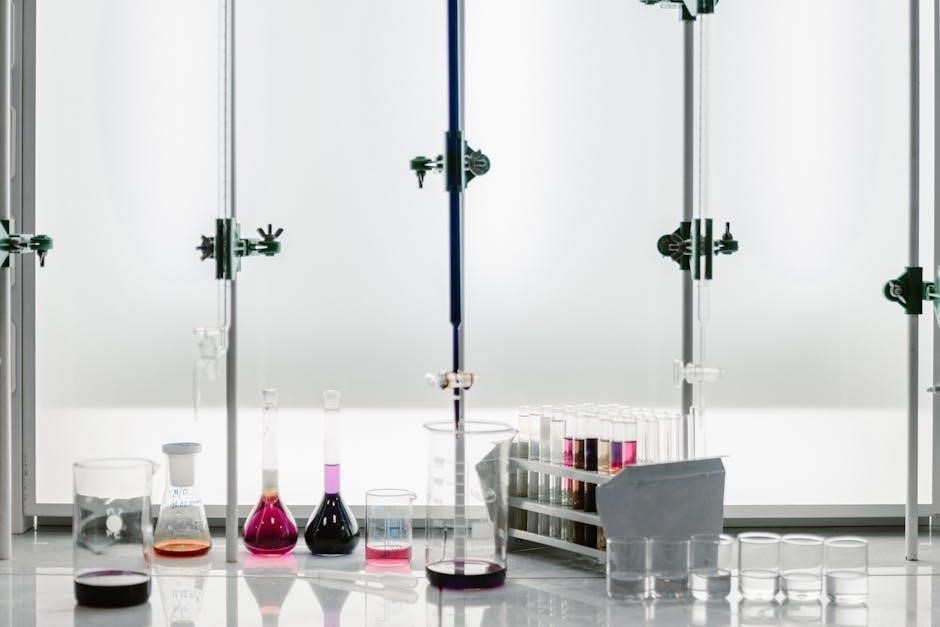
3․2 Microscopy in Microbiology: Types and Techniques
Microscopy is a cornerstone of microbiology, enabling the visualization of microorganisms and their structures․ Light microscopy, the most commonly used type, allows researchers to observe live cells and track their movements․ Electron microscopy provides higher resolution, revealing fine structural details for species identification and interaction studies․ Fluorescence microscopy uses dyes to differentiate microbial species, aiding in environmental and medical diagnostics․ Other techniques include phase-contrast microscopy for unstained cells and dark-field microscopy for observing cell motility․ These tools enhance our understanding of microbial behavior, morphology, and interactions, driving advancements in research and practical applications across medicine, ecology, and biotechnology․
3․3 Staining Methods: Gram, Acid-Fast, and Others
Staining methods are essential in microbiology for identifying and differentiating microorganisms․ The Gram stain is a fundamental technique, distinguishing bacteria into Gram-positive and Gram-negative groups based on cell wall composition․ Acid-fast staining, notably the Ziehl-Neelsen method, identifies acid-fast bacteria like Mycobacterium tuberculosis, crucial in diagnosing infections․ Other techniques include endospore staining for Bacillus and Clostridium species, capsule staining to visualize polysaccharide layers, and flagella staining to study motility․ Specialized stains like methylene blue and safranin are used in specific scenarios․ These methods enhance microbial visualization, aiding in diagnosis, research, and classification, and are widely applied in clinical and laboratory settings to understand microbial characteristics and their roles in health and disease․
3․4 Molecular Biology Techniques in Microbiology
Molecular biology techniques have revolutionized microbiology by enabling precise identification, analysis, and manipulation of microbial genomes․ Polymerase Chain Reaction (PCR) and quantitative PCR (qPCR) amplify DNA for detailed study, while DNA sequencing reveals genetic compositions․ Techniques like Reverse Transcription PCR (RT-PCR) analyze RNA, aiding in understanding gene expression․ Gene sequencing identifies pathogens and tracks outbreaks, crucial for public health․ Next-Generation Sequencing (NGS) offers high-throughput analysis of microbial communities․ These methods are essential for diagnosing infections, studying antimicrobial resistance, and developing targeted therapies․ Metagenomics and CRISPR-Cas9 further expand capabilities, enabling genome editing and exploring microbial diversity․ These tools are vital for advancing microbiological research and addressing global health challenges․
3․5 Immunological Methods: ELISA, PCR, and Sequencing
Immunological methods are cornerstone techniques in microbiology for detecting and analyzing pathogens․ Enzyme-Linked Immunosorbent Assay (ELISA) is widely used to detect specific antibodies or antigens, aiding in diagnosing infections like HIV and hepatitis․ Polymerase Chain Reaction (PCR) amplifies DNA sequences, enabling identification of viral or bacterial genetic material․ Sequencing technologies provide detailed genetic information, crucial for understanding pathogen mutations and tracking outbreaks․ These methods are essential for accurate disease diagnosis, treatment monitoring, and research․ ELISA offers rapid results, while PCR and sequencing provide high sensitivity and specificity․ Together, they enhance our ability to study microbial interactions and develop targeted therapies, advancing both clinical and research applications in microbiology․

Applications of Microbiology
Microbiology applies to medicine, environmental conservation, industrial production, and food safety, driving advancements in disease diagnosis, ecological balance, biotechnology, and ensuring safe food production practices globally․
4․1 Medical Microbiology: Diagnosis and Treatment
Medical microbiology is crucial for diagnosing and treating infections․ It involves identifying pathogens like bacteria, viruses, and fungi through laboratory tests such as Gram staining and PCR․ These methods help determine the causative agent of diseases, enabling targeted antibiotic therapy․ Microbiological cultures are used to isolate pathogens and test their susceptibility to antimicrobial agents, ensuring effective treatment plans․ Immunological techniques, such as ELISA, detect specific antibodies, aiding in the diagnosis of infections․ Molecular biology tools, like sequencing, provide insights into pathogen genetics, helping combat antimicrobial resistance․ Accurate diagnosis and appropriate treatment are essential for patient recovery and preventing disease spread, making medical microbiology a cornerstone of healthcare․
4․2 Environmental Microbiology: Ecology and Conservation
Environmental microbiology explores the roles of microorganisms in ecosystems, focusing on their interactions with the environment and their impact on ecological balance․ Microbes play a crucial role in nutrient cycling, decomposition, and the degradation of pollutants, making them vital for bioremediation efforts․ They are also essential in soil fertility, plant growth, and water purification․ Understanding microbial diversity in habitats like forests, oceans, and soil is key to conservation efforts․ Microbiological techniques are used to monitor environmental health and develop strategies to mitigate the effects of climate change․ By studying microbial communities, scientists can address issues such as pollution, deforestation, and biodiversity loss, promoting sustainable practices and ecosystem restoration․
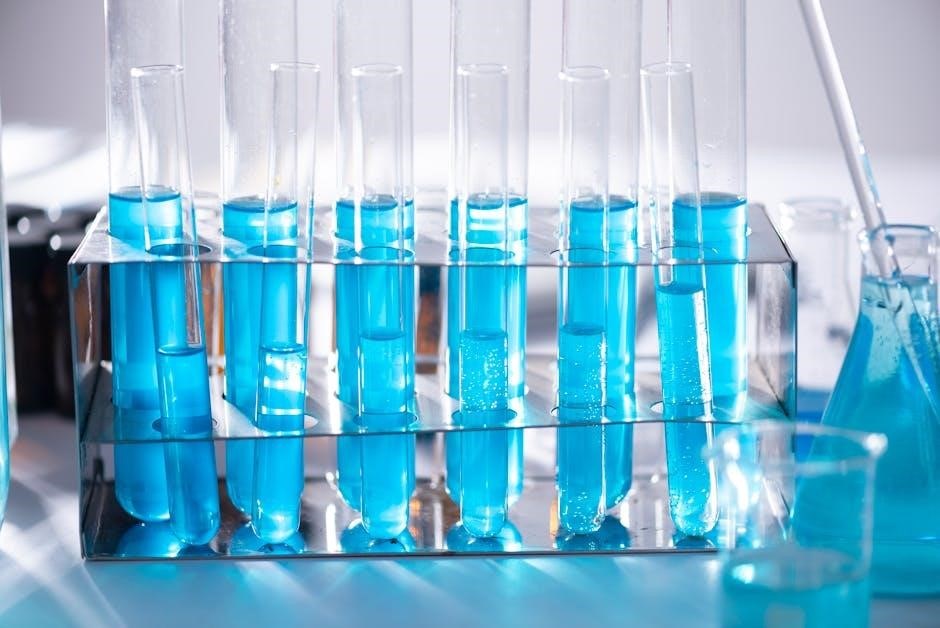
4․3 Industrial Microbiology: Biotechnology and Production
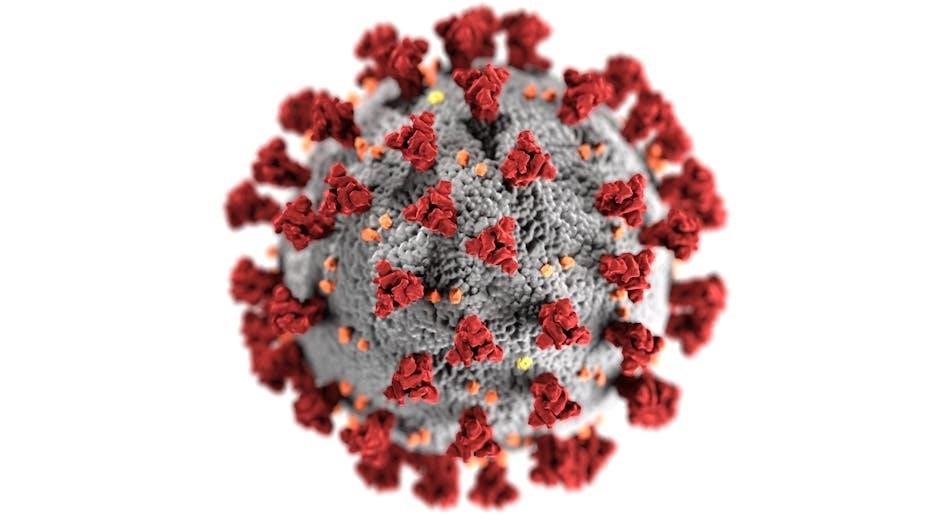
Industrial microbiology leverages microorganisms to produce goods essential for human life and industry․ It involves the use of bacteria, fungi, and other microbes in biotechnology to manufacture enzymes, antibiotics, vaccines, and biofuels․ Microbial fermentation is a cornerstone of this field, enabling large-scale production of substances like insulin, produced by engineered E․ coli, and penicillin from Penicillium․ Advances in metabolic engineering and CRISPR technology have enhanced microbial yield and efficiency․ This sector also explores alternative production methods, such as bio-based chemicals, reducing reliance on petroleum․ Industrial microbiology drives innovation, supporting global healthcare, agriculture, and sustainable development while addressing environmental challenges through eco-friendly solutions․ Its applications continue to expand, shaping modern biotechnology and industrial processes․
4․4 Food Safety and Microbiology
Food safety and microbiology are closely intertwined, focusing on preventing foodborne illnesses caused by harmful microorganisms․ Microbiological testing identifies pathogens like Salmonella, E․ coli, and Staphylococcus aureus, ensuring safe consumption․ Proper food handling, storage, and preservation techniques, such as pasteurization and sterilization, inhibit microbial growth․ Regulatory standards, including HACCP, guide the food industry in maintaining hygiene and quality․ Microbiological analysis employs methods like PCR and ELISA to detect contaminants rapidly․ Understanding microbial ecology in food systems helps predict and control spoilage, extending shelf life․ Collaborative efforts between scientists, policymakers, and producers are essential to safeguard public health and reduce foodborne diseases globally, ensuring a secure food supply chain from production to consumption․
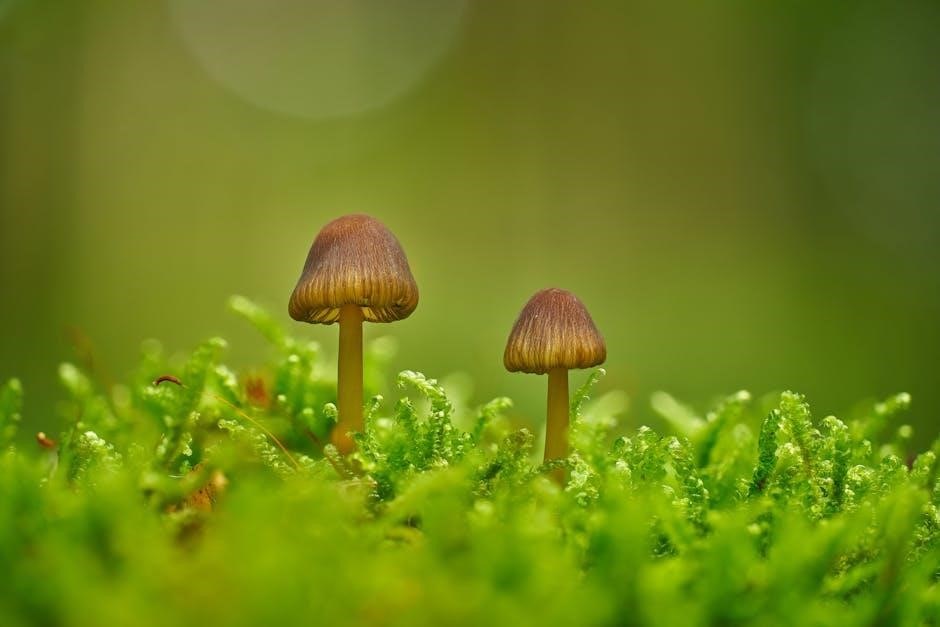
Emerging Trends in Microbiology
Emerging trends in microbiology involve cutting-edge technologies and innovative approaches to understand microbial interactions and their applications in medicine, environmental science, and beyond․
5․1 CRISPR Technology and Its Impact
CRISPR (Clustered Regularly Interspaced Short Palindromic Repeats) technology is a revolutionary genome-editing tool derived from bacterial immune systems․ It allows precise modifications to DNA, enabling scientists to target and alter specific genes․ This breakthrough has transformed microbiology by enabling the study of microbial genomes with unprecedented accuracy․ CRISPR’s applications include developing novel antimicrobial therapies, improving agricultural crops, and advancing environmental bioremediation․ Its impact extends to treating genetic diseases, creating synthetic biofuels, and enhancing food safety․ However, ethical concerns and potential unintended consequences highlight the need for careful regulation․ CRISPR’s versatility has made it a cornerstone of modern microbiological research, driving innovation across diverse fields․
5․2 Microbiome Research: Gut, Skin, and Beyond
Microbiome research explores the diverse communities of microorganisms inhabiting various body sites, such as the gut, skin, and beyond․ The gut microbiome plays a crucial role in digestion, immunity, and overall health, while the skin microbiome acts as a protective barrier․ Recent studies have revealed links between microbiome imbalances and conditions like obesity, diabetes, and skin disorders․ Advances in sequencing technologies have enabled detailed analysis of microbial diversity and function․ Understanding these complex ecosystems holds promise for developing personalized treatments, improving disease prevention, and enhancing human well-being․ This field continues to expand, uncovering the profound impact of microbes on human health and ecology․
5․3 Antimicrobial Resistance: Challenges and Solutions
Antimicrobial resistance (AMR) poses a significant global health challenge, driven by the overuse and misuse of antibiotics, leading to the emergence of “superbugs․” These resistant pathogens complicate the treatment of infections, increasing mortality and healthcare costs․ Key challenges include the rapid spread of resistant genes, insufficient development of new antibiotics, and improper disposal of antimicrobials in the environment․ Solutions involve improving antibiotic stewardship, promoting alternative therapies like bacteriophage treatment, and enhancing public awareness․ Research into novel antimicrobial compounds and vaccines is critical․ Global collaboration and policies to regulate antibiotic use are essential to mitigate this growing threat and safeguard public health for future generations․
5․4 COVID-19 and the Role of Microbiology
The COVID-19 pandemic underscored the critical role of microbiology in understanding and combating infectious diseases․ Microbiologists played a pivotal role in identifying SARS-CoV-2, developing diagnostic tests, and tracking viral variants․ The application of microbiological techniques, such as PCR and genome sequencing, was essential for detecting and monitoring the virus․ Additionally, microbiology contributed to the rapid development of vaccines and antiviral therapies, saving millions of lives․ The pandemic also highlighted the importance of global scientific collaboration and the need for continued investment in microbiological research․ It has left a lasting impact on public health practices, emphasizing the importance of hygiene, vaccination, and preparedness for future microbial threats․
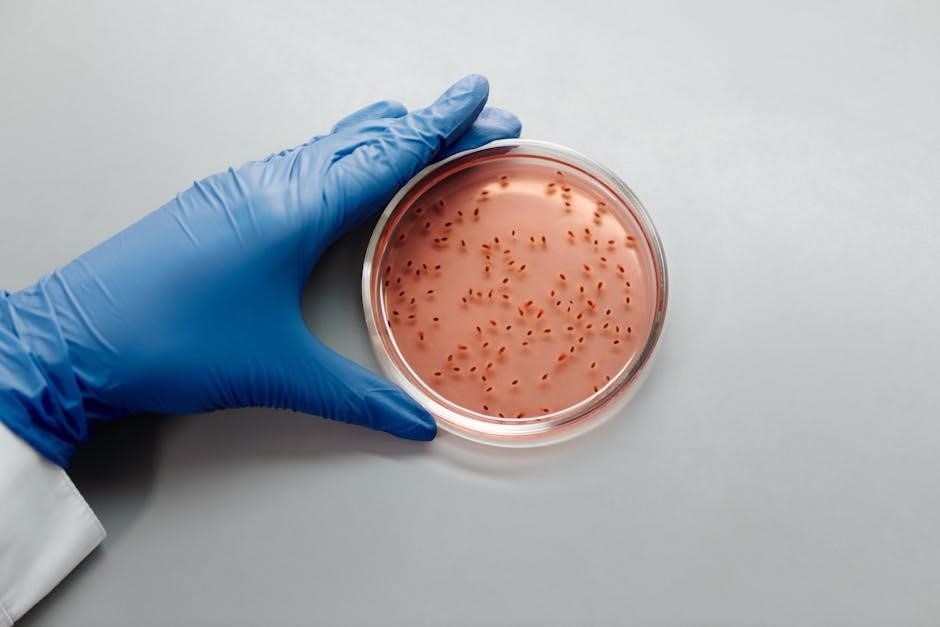
Resources for Further Learning
Discover recommended textbooks, scientific journals, and online courses for in-depth microbiology studies, offering comprehensive insights and practical knowledge to enhance your understanding of microbiological concepts and applications․
6․1 Recommended Textbooks and Journals
For in-depth learning, essential textbooks like Microbiology: An Evolving Science and Prescott’s Microbiology provide foundational knowledge․ Journals such as Nature Microbiology, Science, and Applied and Environmental Microbiology offer cutting-edge research․ These resources cover diverse topics, from bacterial genetics to environmental microbiology, ensuring a comprehensive understanding․ They are ideal for students, researchers, and professionals seeking detailed insights․ Additionally, using boolean operators like AND, OR, and NOT in searches can help refine results, while truncation symbols broaden search possibilities․ This combination of textbooks and journals, along with advanced search strategies, is invaluable for mastering microbiology․
6․2 Online Courses and Tutorials
and Microbial Ecology․ These courses provide interactive learning experiences, including video lectures, quizzes, and discussion forums․ They are designed for both beginners and advanced learners, covering topics like microbial genetics, immunology, and environmental microbiology․ Tutorials often include practical exercises, such as virtual lab simulations, to enhance hands-on understanding․ Additionally, using search strategies like boolean operators and truncation symbols can help learners find specific courses or materials efficiently․ These resources are invaluable for self-paced learning and staying updated on the latest advancements in microbiology․
PDF microbiology serves as a vital resource for understanding microorganisms, offering insights into their roles in health, environment, and technology․ Modern tools like search strings and online courses enhance learning experiences, ensuring accessibility and depth for scholars and enthusiasts alike․
7․1 The Future of Microbiology
The future of microbiology is dynamic and driven by advancing technologies like CRISPR and microbiome research․ These innovations are transforming our understanding of microorganisms, enabling breakthroughs in disease treatment, agriculture, and environmental conservation․ The rise of antimicrobial resistance demands urgent solutions, while the COVID-19 pandemic has highlighted the critical role of microbiology in global health․ Digital resources, such as PDFs, play a key role in disseminating knowledge, making complex microbiological concepts accessible to a broader audience․ As research evolves, microbiology will continue to address global challenges, fostering a healthier and more sustainable future․ The integration of technology and microbiology promises endless possibilities for scientific advancement and practical applications․
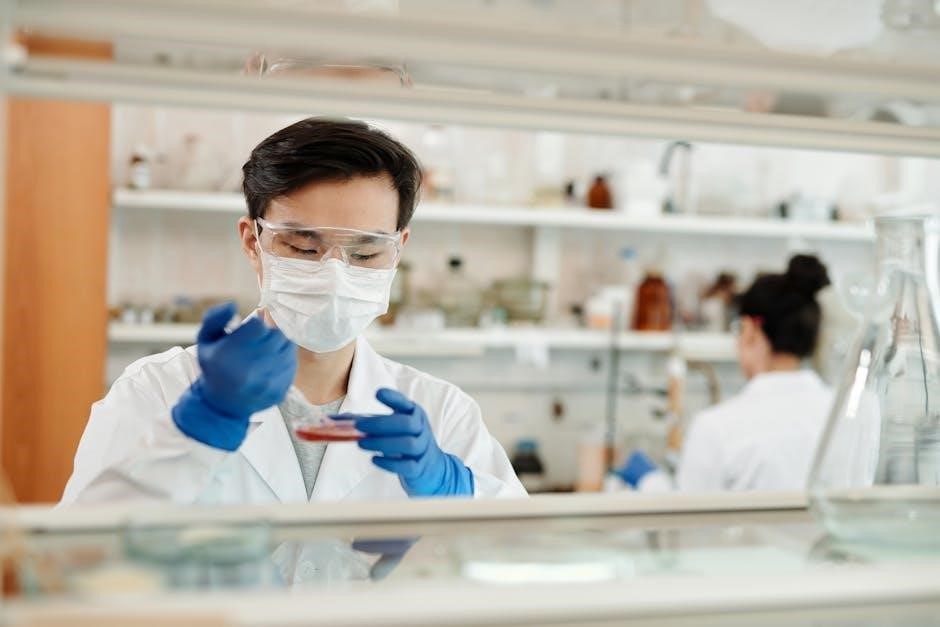
7․2 Final Thoughts on the Importance of Microbiology
Microbiology is a cornerstone of modern science, underpinning advancements in medicine, environmental conservation, and industry․ Its study has unveiled the intricate roles of microorganisms in ecosystems, human health, and biotechnology․ From developing life-saving vaccines to addressing global challenges like antimicrobial resistance, microbiology remains indispensable․ The field’s contributions to understanding diseases, improving food safety, and harnessing microbial potential for industrial processes highlight its profound impact․ As we face emerging threats, microbiology continues to provide vital solutions, ensuring a healthier and more sustainable future․ Its importance cannot be overstated, as it bridges the gap between scientific discovery and practical applications, shaping a better world for generations to come․
